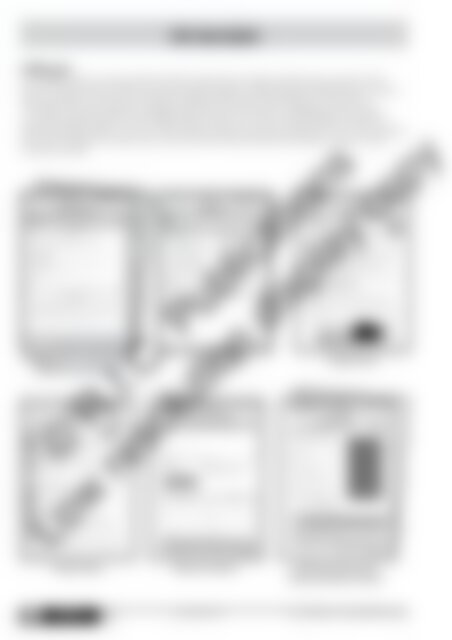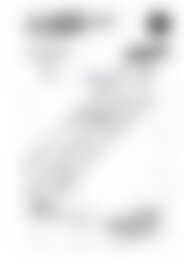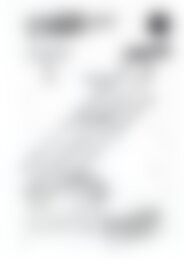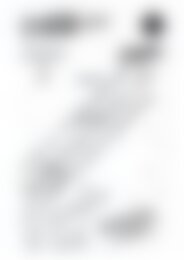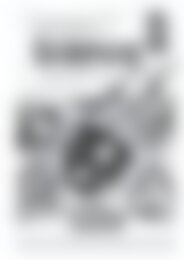6172RB Science a STEM approach Year 2 low res watermark
Create successful ePaper yourself
Turn your PDF publications into a flip-book with our unique Google optimized e-Paper software.
Unit description<br />
<strong>STEM</strong> project<br />
The <strong>STEM</strong> project provides students with the opportunity to apply what they have learned in the<br />
previous science lessons while incorporating technologies, engineering and mathematics concepts<br />
where possible. The project entails group collaboration and an extended learning period of<br />
3–4 weeks. This gives students a real-life experience of working with ‘colleagues’ to share ideas<br />
and test designed solutions. Each <strong>STEM</strong> project contains an overview listing <strong>STEM</strong> concepts and<br />
alternative project ideas, curriculum links, teacher notes and a group assessment rubric, and a project<br />
brief and checklist for students. Any <strong>res</strong>ource sheets required are also provided, as well as a selfassessment<br />
sheet.<br />
<strong>STEM</strong> project<br />
<strong>Science</strong> Understanding<br />
<strong>STEM</strong> curriculum links<br />
SCIENCE CURRICULUM<br />
• Different materials can be combined for a particular purpose (ACSSU031)<br />
<strong>Science</strong> as a Human Endeavour<br />
<strong>Science</strong> Inquiry Skills<br />
R.I.C. Publications® – www.ricpublications.com.au 978-1-925431-95-7 YEAR<br />
67<br />
YEAR<br />
A <strong>STEM</strong> APPROACH<br />
<strong>Science</strong>:<br />
<strong>STEM</strong> project overview and<br />
<strong>STEM</strong> curriculum links<br />
2<br />
<strong>STEM</strong> project<br />
• <strong>Science</strong> involves observing, asking questions about, and describing changes in, objects and events (ACSHE034)<br />
• People use science in their daily lives, including when caring for their environment and living things (ACSHE035)<br />
Planning and conducting<br />
• Participate in guided investigations to explore and answer questions (ACSIS038)<br />
Processing and analysing data and information<br />
• Use a range of methods to sort information, including drawings and provided tables and through discussion, compare<br />
observations with predictions (ACSIS040)<br />
Communicating<br />
• Rep<strong>res</strong>ent and communicate observations and ideas in a variety of ways (ACSIS042)<br />
TECHNOLOGIES CURRICULUM<br />
Design and Technologies Knowledge and Understanding<br />
• Explore the characteristics and properties of materials and components that are used to produce designed solutions<br />
(ACTDEK004)<br />
Chemical sciences<br />
LIVING IN A MATERIAL WORLD<br />
Design and Technologies Processes and Production Skills<br />
• Explore needs or opportunities for designing, and the technologies needed to realise designed solutions (ACTDEP005)<br />
• Generate, develop and record design ideas through describing, drawing and modelling (ACTDEP006)<br />
• Use materials, components, tools, equipment and techniques to safely make designed solutions (ACTDEP007)<br />
• Use personal preferences to evaluate the success of design ideas, processes and solutions including their care for<br />
environment (ACTDEP008)<br />
• Sequence steps for making designed solutions and working collaboratively (ACTDEP009)<br />
Digital Technologies Knowledge and Understanding<br />
• Recognise and explore digital systems (hardware and software components) for a purpose (ACTDIK001)<br />
Measurement and Geometry<br />
<strong>STEM</strong> project overview<br />
Oil spill clean-up<br />
Students combine materials to recreate an oil spill and then devise a method to remove the oil<br />
from the water and from bird feathers that have been affected by the oil.<br />
Concepts overview:<br />
<strong>Science</strong><br />
• Apply knowledge of materials and their properties to remove oil from water.<br />
• Apply knowledge of mixing different materials to remove oil from feathers.<br />
• Conduct investigations to find suitable solutions.<br />
• Create a video to communicate the <strong>res</strong>ults of the oil spill clean-up attempt.<br />
• People use science in their everyday lives to understand how to use materials to clean up<br />
environmental disasters.<br />
Technology/Engineering<br />
• Plan steps collaboratively.<br />
• Explore and test the properties of materials for use in a designed solution.<br />
• Evaluate and revise the material used for absorbing oil from water or the substance used to<br />
remove oil from feathers.<br />
• Use a digital application to record a video.<br />
Mathematics<br />
• Use informal measurement to add oil, water and cocoa powder to a bowl.<br />
Alternative project ideas:<br />
• Students design and create an outdoor water trolley using recycled materials. Students select<br />
materials based on their properties to create a trolley that is waterproof and is strong enough<br />
to hold five one-litre jugs of water.<br />
• Students design and create decorated biscuits. Students measure the ingredients and mix<br />
materials together to create the biscuits, fol<strong>low</strong>ing the simple recipe at . Once cooked and cooled, students combine icing and sweets to decorate each<br />
biscuit.<br />
• Students create either their design for an underwater house from Lesson 3 or their design for a<br />
toy from Lesson 4, using the materials labelled on their designs.<br />
MATHEMATICS CURRICULUM<br />
Chemical sciences<br />
LIVING IN A MATERIAL WORLD<br />
• Compare and order several shapes and objects based on length, area, volume and capacity using appropriate uniform<br />
informal units (ACMMG037)<br />
978-1-925431-95-7 R.I.C. Publications® – www.ricpublications.com.au<br />
2<br />
YEAR<br />
66 <strong>Science</strong>: A <strong>STEM</strong> APPROACH<br />
<strong>STEM</strong> project<br />
70 <strong>Science</strong>: YEAR<br />
A <strong>STEM</strong> APPROACH 2<br />
Project steps<br />
Chemical sciences<br />
LIVING IN A MATERIAL WORLD<br />
Investigate<br />
Learn about oil spills and test materials.<br />
As a class, watch the video about oil spills by scanning<br />
this QR code.<br />
Learn about what absorbency is and what materials have this property.<br />
Test three materials to see which is the most absorbent.<br />
Test three substances to see which mixes best with oil.<br />
Design, plan and manage<br />
Plan your oil spill and collect your clean-up materials.<br />
Plan how you will recreate an oil spill and what sort of container will<br />
be used.<br />
Collect the materials that will be used to carry out the clean-up, based<br />
on your investigations.<br />
Create<br />
Create your oil spill, then clean it up.<br />
Create the oil spill by pouring water into your chosen container, then<br />
adding vegetable oil and cocoa powder.<br />
Dip the feather in the mixture to soak up the oil, then remove and set<br />
aside.<br />
Absorb the oil from the water.<br />
Remove the oil from the feather.<br />
Check and make changes<br />
Check if the oil is fully removed from the water. If it isn’t, consider if<br />
there is a different material that would be more absorbent.<br />
Check that the feather is completely clean. If it isn’t, think about<br />
another substance you didn’t test that might be better at removing oil.<br />
Communicate<br />
As a group, record a video explaining how you absorbed the oil from<br />
the water and what substance you decided to add to the oily feather<br />
to clean it.<br />
978-1-925431-95-7 R.I.C. Publications® – www.ricpublications.com.au<br />
67<br />
<strong>STEM</strong> project<br />
Teacher notes<br />
<strong>STEM</strong> project:<br />
Students recreate an oil spill using a mixture of oil, cocoa powder and water. They devise a<br />
method to remove the oil from the water by testing different materials to absorb the oil, based<br />
on the properties required. Students then devise a method to remove oil from feathers by testing<br />
different materials to clean the feathers.<br />
Estimated duration: 3–4 weeks<br />
1. Introduce the project<br />
• Play a short Behind the News video to the<br />
class to introduce what an oil spill is, by<br />
clicking on the image at . Students can rewatch the<br />
video by scanning the QR code on their<br />
project brief page on page 69.<br />
• Display page 69 to the class and introduce<br />
the project brief—to remove oil from<br />
the water using an absorbent material,<br />
and remove oil from feathers using an<br />
ingredient that will mix with oil. Students<br />
will first need to recreate an oil spill by<br />
making a mixture of water, oil and cocoa<br />
powder in a plastic tub or large bowl.<br />
• Clarify any details students do not<br />
understand.<br />
2. Investigate<br />
• As a class, explore what absorption is by<br />
looking at the PowerPoint p<strong>res</strong>entation at<br />
. Note: The<br />
last 4 slides don’t need to be viewed as<br />
they relate to a specific investigation of the<br />
absorbency of paper towels.<br />
• In small groups, students brainstorm<br />
materials they think are absorbent and<br />
would like to test. Students then investigate<br />
the absorbency of three materials using the<br />
template on page 71.<br />
• Students also investigate which ingredients<br />
can be mixed with oil, using the template<br />
on page 72.<br />
Chemical sciences<br />
LIVING IN A MATERIAL WORLD<br />
3. Design, plan and manage<br />
• Students plan how they will recreate an oil<br />
spill and what container will be used.<br />
• Students collect the materials and<br />
substances they will need for the oil cleanup.<br />
4. Create<br />
• Students conduct the oil-absorbing<br />
challenge and the feather-cleaning<br />
challenge, based on the <strong>res</strong>ults of their<br />
earlier investigations.<br />
5. Evaluate and refine<br />
• Students re-read the design brief to<br />
ensure they have included all the required<br />
components and have satisfied the criteria<br />
and checklist. They make changes if<br />
necessary.<br />
6. Communicate<br />
• Students record a video explaining how<br />
they absorbed the oil from the water and<br />
what substance they decided to add to the<br />
oily feather to clean it.<br />
• Share the video with the class.<br />
978-1-925431-95-7 R.I.C. Publications® – www.ricpublications.com.au<br />
2<br />
YEAR<br />
68 <strong>Science</strong>: A <strong>STEM</strong> APPROACH<br />
Teacher notes<br />
Chemical sciences<br />
<strong>STEM</strong> project<br />
Oil absorption investigation<br />
LIVING IN A MATERIAL WORLD<br />
Student names:<br />
Hypothesis: Which materials do you think are absorbent?<br />
Circle which three you will test.<br />
Materials:<br />
Procedure:<br />
• vegetable oil<br />
1. Use the pipette to place drops of oil onto<br />
• pipette/eye-dropper each of your three materials.<br />
2. Observe and record the <strong>res</strong>ults.<br />
•<br />
•<br />
•<br />
Results:<br />
Material<br />
Conclusion: Which material is the most absorbent?<br />
Result<br />
R.I.C. Publications® – www.ricpublications.com.au 978-1-925431-95-7 YEAR <strong>Science</strong>:<br />
2 A <strong>STEM</strong> APPROACH 71<br />
Student name:<br />
CRITERIA<br />
<strong>Science</strong>: YEAR<br />
2<br />
74 A <strong>STEM</strong> APPROACH<br />
<strong>STEM</strong> project<br />
Group members:<br />
Project task:<br />
Recreate an oil spill and devise a way to absorb oil using an absorbent material, and<br />
select a substance to remove oil from a feather.<br />
<strong>Science</strong> knowledge<br />
Understands that materials have properties that can be used for a purpose.<br />
Understands that substances can be mixed for a purpose; e.g. oil and detergent.<br />
<strong>Science</strong> skills<br />
Conducts an investigation into which materials are absorbent.<br />
Conducts an investigation into which substances will mix with oil and can be used as a<br />
cleaning agent.<br />
Records information and observations from the investigation using a table.<br />
Communicates science knowledge successfully using a digital video.<br />
Technology/Engineering skills<br />
Devises a suitable recreation of an oil spill.<br />
Discusses and plans how to clean up the oil spill and feather, and collects the<br />
appropriate materials needed.<br />
Evaluates and revises the material or substance to improve the oil spill clean-up.<br />
Successfully uses digital technology to film a short video.<br />
Mathematics<br />
Uses informal measurement to create a mixture.<br />
Group skills<br />
Chemical sciences<br />
LIVING IN A MATERIAL WORLD<br />
Project brief<br />
OIL SPILL CLEAN-UP<br />
The problem<br />
An oil spill has occurred in the ocean. Your job is to find<br />
the quickest and most effective way to remove the oil<br />
from the water and save the birds trapped in the oil slick.<br />
R.I.C. Publications® – www.ricpublications.com.au 978-1-925431-95-7 YEAR <strong>Science</strong>:<br />
2 A <strong>STEM</strong> APPROACH 69<br />
Project brief<br />
Group assessment rubric<br />
Each group member contributed equally to the project and had a clear role.<br />
Each group member collaborated and worked well together to solve problems.<br />
Each group member communicated positively and listened to others.<br />
Chemical sciences<br />
LIVING IN A MATERIAL WORLD<br />
1 = Be<strong>low</strong> expectations<br />
2 = Meeting expectations<br />
3 = Above expectations<br />
978-1-925431-95-7 R.I.C. Publications® – www.ricpublications.com.au<br />
<strong>STEM</strong> project<br />
The task<br />
1. You need to make an oil spill mixture by combining water, oil and<br />
cocoa powder.<br />
2. You need to work out what material will best soak up the oil from<br />
the water. What properties do you need the material to have?<br />
3. You need to work out what ingredient will best remove the oil<br />
from the feathers. What ingredient will mix with oil?<br />
4. You will then make a video describing the best method and how<br />
this could be applied to the real world.<br />
Important things you need to do!<br />
• You must work in groups of 2–3 students.<br />
• You must make an oil spill by combining water, oil and cocoa<br />
powder.<br />
• You must dip the feathers into the oil spill and coat them well.<br />
• You must remove the oil from the water by absorbing it with a<br />
material.<br />
• You must remove the oil from the feathers by adding a substance to<br />
clean it.<br />
Chemical sciences<br />
LIVING IN A MATERIAL WORLD<br />
<strong>STEM</strong> project: Oil spill clean-up<br />
I listened to the ideas of others.<br />
I gave ideas.<br />
I helped to <strong>res</strong>earch.<br />
I helped collect materials.<br />
I helped with the design plan.<br />
I helped create the design.<br />
The project was easy hard .<br />
The part of the project I liked best was<br />
because<br />
Self-assessment<br />
I could improve my work next time by<br />
Date:<br />
<strong>STEM</strong> project<br />
© R.I.C. Publications<br />
Low <strong>res</strong>olution display copy<br />
I think my work on this project was excellent good fair poor .<br />
R.I.C. Publications® – www.ricpublications.com.au 978-1-925431-95-7 YEAR <strong>Science</strong>:<br />
2 A <strong>STEM</strong> APPROACH 73<br />
.<br />
.<br />
Project steps<br />
Resource sheets<br />
Self-assessment and<br />
Group assessment rubric<br />
vi<br />
<strong>Science</strong>:<br />
A <strong>STEM</strong> APPROACH<br />
YEAR<br />
2<br />
978-1-925431-95-7 R.I.C. Publications® – www.ricpublications.com.au


